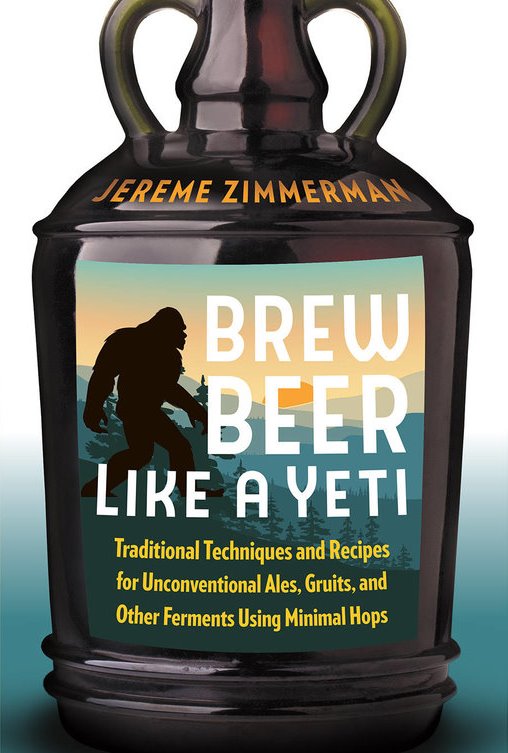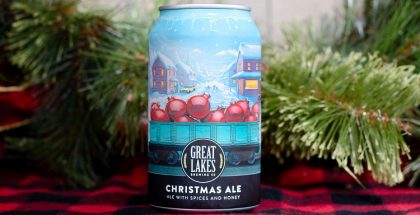Book Review | Brew Beer Like a Yeti Embraces the Unconventional
Eschewing hops in your beer is not the best money-making business model in American craft beer in 2018, but if you’re brewing it for yourself, who cares? Actually, those last two words form a sort of unofficial mantra for Jereme Zimmerman’s attitude toward accepted homebrewing guidelines in his new book. Learn the rules, then break them.

Brew Beer Like a Yeti: Traditional Techniques and Recipes for Unconventional Ales, Gruits, and Other Ferments Using Minimal Hops by Jereme Zimmerman (Chelsea Green Publishing, 2018)
If you take Charlie Papazian’s famous words of wisdom about leaving worry behind and just enjoying the beer and run them through the mouth of a man who listens to Norse-themed metal bands and contributed to the development of a tabletop game about drunk Vikings (designed by his friend Dave Brown), you get the mindset of Zimmerman’s Brew Beer Like a Yeti. The book is a follow-up to his popular Make Mead Like a Viking, and offers a low-tech, low-stress mode of homebrewing in line with his family’s sustainable lifestyle in Kentucky.
Zimmerman isn’t opposed to hops. He brews conventional beers with hops and includes them in many of the recipes in his book. Rather, he sees a world of botanical options out there for seasoning beer, and sees no reason for hops to steal the show. With an itch to explore historical brewing methods, Zimmerman unpacks brewing details from Norse, Celtic, Sumerian, and other ancient civilizations and seeks to apply them to modern homebrewing. Styles guidelines melt away, drink categories (wine, beer, mead, etc) blur together, and the fastidious tedium of modern homebrewing is disrupted as Zimmerman adds microorganisms to fermentable sugars and drinks what comes out on the other side.
If you’re looking for an introduction to the basics of homebrewing, this isn’t it. But if you’re looking for ways to spice up your homebrewing when the hobby gets a bit stale, this is a fun resource to turn to.
I recently spoke with Jereme about his favorite commercial beers, why historical brewing methods appeal to him, and what it means to brew like a yeti in his daily life.

PorchDrinking: I always start with the most important questions first: What have you been drinking and enjoying lately?
Jereme Zimmerman: While I do have a couple of favorites I return to often (pretty much anything by Ommegang or Unibroue, for example), I’m always looking for new breweries and esoteric brews, particularly those that emphasize ingredients other than hops. I am by no means anti-hops, but have little tolerance for IPAs and feel there are so many other ingredients that are more suited to my palate. Some standbys I enjoy on a regular basis that I feel balance hops and malt nicely are New Belgium Fat Tire and Deschutes Mirror Pond Pale Ale.
You have a very unconventional perspective on homebrewing, turning a lot of accepted wisdom on its head. What kind of reactions do you get to some of your relaxed assertions from by-the-books brewers, and what do you say to folks who believe precision and consistency are key in brewing?
I was a little worried about this initially when I first started writing and talking about brewing publicly, but I’ve found that, in general, brewers are a friendly sort and have a penchant for experimentation. This isn’t to say that I don’t occasionally get unpleasant comments on the Internet, but those comments are vastly outnumbered by those from enthusiastic people. I didn’t go into this with an attitude of turning accepted modern wisdom on its head, or even presenting my style of brewing as something unique that I wanted to bludgeon the brewing world with. When I started writing about historical brewing initially, I quickly found there were a lot of people drooling for more information. While I still brew my share of modern by-the-books brews, my approach more and more is to research historical brews or brews indigenous to a particular region that are still being brewed by the old ways today.
Since I want to be as authentic as possible, I forego modern standards such as hydrometers, sanitizers, and hyper-specific recipes. I mostly use modern equipment such as carboys and airlocks, simply because they’re convenient and they’re not all that different from what would have been used historically. Over time I found that I was making perfectly tasty brews this way (with some exceptions).
I give a great deal of credit to three authors for giving me “permission” to brew this way. One is Stephen Harrod Buhner, whose classic Sacred and Herbal Healing Beers: The Secrets of Ancient Fermentation completely opened my eyes to the world of historical and herbal brewing. Another is Wild Fermentation by Sandor Katz, and finally, Radical Brewing by Randy Mosher. Buhner’s book was fascinating for its history, but also because of the many herbs he goes into detail about. Sandor Katz brought up a very good point in his book and when I saw him speak: he had grown weary on the insistence of modern brewing on specificity, consistency and extreme focus on details; when he traveled to Africa and tasted all manner of amazing brews made under very rudimentary conditions with pretty much zero modern conveniences, he returned home with an entirely new mindset. Finally, Randy Mosher, while extremely detail-oriented in much of his work, opened me up to all kinds of different ingredients, historical brews, and the concept of brewing just for the fun and experimentation of it.
To those who believe precision and consistency is key in brewing, I would have to say that I completely agree with them. I have friends who are very much focused on the chemistry of brewing who make amazing beers. I have also had many beers brewed under the rigors of the Reinheitsgebot and can completely see why the restrictions presented by that law have resulted in a brewing tradition that consistently turns out quality beers. I don’t just throw all the rules out the door. I learn the rules and then experiment with breaking them. To those who want to emulate the brews they’re having from breweries who brew the modern way, attention to details, precision, and consistency are certainly key. If you want to try to make something that’s different, based on a historical style, or even a bit funky, the modern rules are going to hold you back. Often I’ll plan out a specific brew but sometimes I’ll just take whatever grains and hops I have available from previous brews and put something together loosely based on a particular style.
Beyond brewing, you live a holistically rustic, sustainable lifestyle. How does homebrewing (like a yeti, of course) fit into your regular life as a homesteader?
“Homesteader” is a strange term to me. Essentially, the way I live is according to a variety of mindsets that have become buzzwords. “Sustainable living,” “back to the land,” “locavore,” “survivalism,” “urban homesteading” and “modern homesteading” are all terms that fit into what I do to a certain extent. My personal preference is just “living.” I grew up in a family with five kids, all of us homeschooled during some portion of our school years. My parents bought an extremely rundown farmhouse situated on around 30 acres. We all grew up helping tear down walls, build extensions, fix mistakes, and help around the farm. We raised all manner of animals and did a lot of gardening. My mom preserved as much of the garden as she could and my dad hunted and butchered animals to put in the freezer. He also made a lot of wine, primarily from ingredients he grew or foraged. So, when I say I call it “living,” that’s simply because it was the only way I knew how to live for much of my life. When I moved away from the farm to pursue an English degree at Berea College. I moved to Seattle when I graduated, and eventually decided it was time to head back to Berea. Now, I live in a very old house in the oldest part of town with a yard that’s just big enough for me to do a decent amount of gardening. I’m working on keeping bees but haven’t had a lot of luck with that yet. I’m lucky to live in a community of people who also do a lot of these things, so I learn from, barter with, and frequent the farmers market stands of folks who have been doing this with much greater success than me. I also ferment or preserve in other ways as much as I can of what I grow or procure in other ways, and butcher the occasional goat or chicken.
As to how homebrewing fits into this life, I find it to be a natural extension. I practice what is now called farmhouse brewing, but in the past was simply part of what nearly every homestead did in preserving the harvest and making their own food and drink. I certainly buy my fair share of ingredients from homebrewing stores, health food stores, and farmers markets, but I try to keep my brewing as local and sustainable as possible.
What are some breweries who are doing interesting things with historic or rustic brewing that you can recommend to readers?
One brewery I’ve recently become particularly fond of is HammerHeart Brewing Company in Minnesota. The head brewer, Austin, took the opportunity to complete an internship with Haandbryggeriet, a brewery he had visited on a trip to Norway. After working under the head brewer, Andreas Riis, for a few months, he returned to the states and headed to Minnesota to start a brewery with his homebrewing buddy Nathaniel. The brews I’ve enjoyed of theirs so far are Flaming Longship (a mildly smoked scotch ale), Thor’s Imperial Porter (a smoked hot pepper imperial porter) and Olaf the Stout (an oak-aged rye stout).
Aeronaut Brewing in Somerville, Massachusetts is one I’m familiar with but haven’t tried yet. From my understanding, they meld history and hard science to create a sustainable, truly local brewery. They have a space where several different companies who produce local, sustainable food run their own operations but also collaborate when possible.
A brewery near me in Lexington, Kentucky, West Sixth Brewing, has been doing something similar for several years. Located in an urban area, they rent a large building (an old bread factory) where various other organizations also share space. One of them is FoodChain, which is a nonprofit that provides education and demonstration on sustainable food systems. Their ultimate goal is to create a closed-loop system where everything they produce circles back. For instance, they raise tilapia and grow microgreens using an aquaponics system. They feed the fish partly with spent grains from West Sixth and then use the fish waste to fertilize garden greens. Just outside of the aquaponics room is Smithtown Seafood, which serves freshly harvested fish and greens that you can have along with a West Sixth beer. They also have other plans in the works, including using spent grains to grow mushrooms in the building’s damp basement, container gardening on the building’s roof, and developing vermicompost from the spent mushroom medium to fertilize hoop-house grow beds. They have recently opened a farm where, among other things, they grow hops and have a fruit orchard, beehives, and places for people to roam the grounds, drink beer, and relax. Both breweries produce unique brews that meld historical technique and beer styles with a modern emphasis on sustainability, localism and terroir.
You mention throughout Brew Beer Like a Yeti that you do sometimes enjoy true-to-style modern craft beers. Given your emphasis on relaxed, rustic brewing techniques, do you feel like beer brewed with technical and scientific rigor and precision misses out on any of that romance of your preferred techniques?
To be perfectly honest, while I’m interested in history and stories pertaining to beer, producing a tasty product in the end is paramount. Yes, there is a certain degree of romance in producing beer this way, but what matters in the end is how it tastes. My low-tech approach is more out of necessity than anything else. I’m a very absent-minded person and have a hard time focusing on things that require a lot of attention and scientific rigor. I barely pulled a D- in high school chemistry and somehow managed to get through my college science and math classes with mostly Cs. So my personal emphasis in brewing beer is to find the simplest way to make a tasty beer. I was stressing out way too much trying to follow some of the highly detailed recipes I came across as I moved beyond extract brewing, and was quickly losing my love for the hobby. I now go by my hero Charlie Papazian’s mantra: “Worrying can spoil your beer more than anything else. Relax. Don’t worry. Have a homebrew.”
In your book, you mention ancient brewing techniques from the Vikings, Celts, Picts, Sumerians, and others. Do you have a historical brewing tradition that most fascinates you, and if so, why?
They all intrigue me, but Nordic brewing is definitely at the top of my list. This isn’t just because I’m a bit obsessed with Nordic culture, but because many of the ancient brewing techniques from that region have never stopped being practiced. Hand-in-hand with this is Neolithic brewing from the British isles and various other parts of Europe. I follow several blogs and research papers from experimental archeologists who are working to emulate exactly how our ancient forebears brewed beer. I hope to do a tour of farmhouse breweries in Nordic and Baltic regions someday but in the meantime sate myself by following blogs from people in the region who are thoroughly documenting these rustic brewing techniques while also providing their own modern technical interpretations. In particular, I closely follow www.brewingnordic.com and www.garshol.priv.no/blog.
If you could help readers take one idea away from Brew Beer Like a Yeti, what would it be?
You’re a Viking Yeti! You can do this! Don’t be afraid to experiment and always let your mistakes lead to your next great brew.
What’s next? Do you have another fermentation book planned after this one?
No idea! I don’t plan my books so much as they find me. My first book Make Mead Like a Viking came about from my early days of blogging and teaching workshops on mead. Over time, a book seemed the natural next step. Brew Beer Like a Yeti was a continuation of Make Mead Like a Viking, as I kept coming across information on historical beer brewing that just didn’t fit in the mead book. I set a bunch of it aside and made notes for when I was ready to continue the journey. I also write a lot of magazine articles on all manner of subjects, but mostly fermentation. I ferment a lot of vegetables, so who knows what will happen there. Right now I’m enjoying seeing where life leads me. I’m sure at some point it will lead me to another book!








Submit a Comment